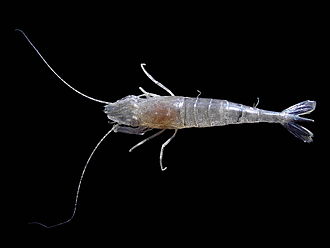Crangonidae
Crangonidae is a family of shrimp within the order Decapoda, which is a group of crustaceans that also includes crabs, lobsters, and other similar creatures. The family Crangonidae is commonly known as the sand shrimps or snapping shrimps due to their habitat preferences and behaviors. Members of this family are characterized by their relatively small size, cryptic coloration, and a body that is more compressed from side to side compared to other shrimps, which allows them to burrow or hide in sandy or muddy substrates.
Description
Crangonidae species typically have a body length ranging from a few centimeters to about 9 cm. They possess a distinctive rostrum that is shorter than that of many other shrimp species and often lacks teeth. Their coloration usually matches their habitat, providing excellent camouflage against predators. This family of shrimps has well-developed pereiopods (walking legs) that are adapted for burrowing and walking on the substrate. The first pair of pereiopods are usually larger and equipped with claws (chelae) that are used for feeding and defense.
Habitat and Distribution
Crangonidae shrimps are found in a wide range of marine environments, from the intertidal zone to depths of several hundred meters. They are predominantly found in cold and temperate waters of the Northern Hemisphere, including the North Atlantic, North Pacific, and the Arctic Ocean. These shrimps prefer sandy or muddy bottoms where they can easily burrow or hide from predators.
Ecology
The diet of Crangonidae shrimps mainly consists of small invertebrates, detritus, and organic matter, which they scavenge from the substrate. They play a significant role in the benthic food web as both predators and prey. Many fish and larger crustaceans prey on Crangonidae shrimps, making them an important link in marine ecosystems.
Reproduction
Crangonidae shrimps exhibit sexual dimorphism, with females generally being larger than males. They reproduce through internal fertilization, and females carry the fertilized eggs attached to their pleopods (swimmerets) until they hatch into free-swimming larvae. The larvae go through several planktonic stages before settling to the bottom and metamorphosing into juvenile shrimps.
Genera
The family Crangonidae includes several genera, with Crangon being the most well-known and widely distributed. Other notable genera include Argis, Paracrangon, and Sclerocrangon.
Conservation
While most Crangonidae species are not currently considered endangered, they are susceptible to habitat loss, pollution, and the impacts of climate change. Overfishing can also reduce their populations, as some species are targeted for human consumption or caught as bycatch in fisheries targeting other species.
This article is a crustacean-related stub. You can help WikiMD by expanding it!
Transform your life with W8MD's budget GLP-1 injections from $125.
W8MD offers a medical weight loss program to lose weight in Philadelphia. Our physician-supervised medical weight loss provides:
- Most insurances accepted or discounted self-pay rates. We will obtain insurance prior authorizations if needed.
- Generic GLP1 weight loss injections from $125 for the starting dose.
- Also offer prescription weight loss medications including Phentermine, Qsymia, Diethylpropion, Contrave etc.
NYC weight loss doctor appointments
Start your NYC weight loss journey today at our NYC medical weight loss and Philadelphia medical weight loss clinics.
- Call 718-946-5500 to lose weight in NYC or for medical weight loss in Philadelphia 215-676-2334.
- Tags:NYC medical weight loss, Philadelphia lose weight Zepbound NYC, Budget GLP1 weight loss injections, Wegovy Philadelphia, Wegovy NYC, Philadelphia medical weight loss, Brookly weight loss and Wegovy NYC
|
WikiMD's Wellness Encyclopedia |
| Let Food Be Thy Medicine Medicine Thy Food - Hippocrates |
Medical Disclaimer: WikiMD is not a substitute for professional medical advice. The information on WikiMD is provided as an information resource only, may be incorrect, outdated or misleading, and is not to be used or relied on for any diagnostic or treatment purposes. Please consult your health care provider before making any healthcare decisions or for guidance about a specific medical condition. WikiMD expressly disclaims responsibility, and shall have no liability, for any damages, loss, injury, or liability whatsoever suffered as a result of your reliance on the information contained in this site. By visiting this site you agree to the foregoing terms and conditions, which may from time to time be changed or supplemented by WikiMD. If you do not agree to the foregoing terms and conditions, you should not enter or use this site. See full disclaimer.
Credits:Most images are courtesy of Wikimedia commons, and templates, categories Wikipedia, licensed under CC BY SA or similar.
Contributors: Prab R. Tumpati, MD

